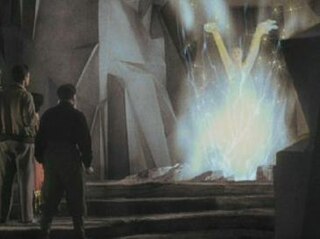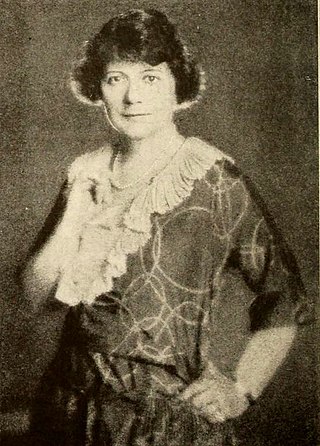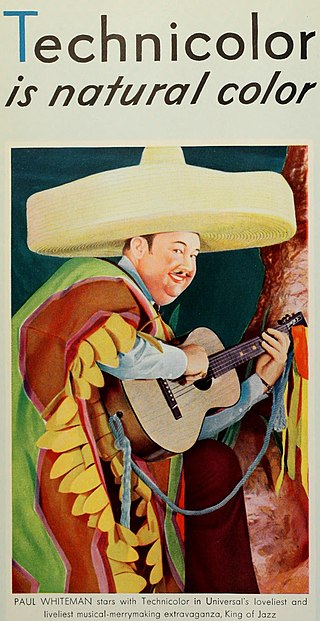Related Research Articles

Film stock is an analog medium that is used for recording motion pictures or animation. It is recorded on by a movie camera, developed, edited, and projected onto a screen using a movie projector. It is a strip or sheet of transparent plastic film base coated on one side with a gelatin emulsion containing microscopically small light-sensitive silver halide crystals. The sizes and other characteristics of the crystals determine the sensitivity, contrast and resolution of the film. The emulsion will gradually darken if left exposed to light, but the process is too slow and incomplete to be of any practical use. Instead, a very short exposure to the image formed by a camera lens is used to produce only a very slight chemical change, proportional to the amount of light absorbed by each crystal. This creates an invisible latent image in the emulsion, which can be chemically developed into a visible photograph. In addition to visible light, all films are sensitive to X-rays and high-energy particles. Most are at least slightly sensitive to invisible ultraviolet (UV) light. Some special-purpose films are sensitive into the infrared (IR) region of the spectrum.

35 mm film is a film gauge used in filmmaking, and the film standard. In motion pictures that record on film, 35 mm is the most commonly used gauge. The name of the gauge is not a direct measurement, and refers to the nominal width of the 35 mm format photographic film, which consists of strips 1.377 ± 0.001 inches (34.976 ± 0.025 mm) wide. The standard image exposure length on 35 mm for movies is four perforations per frame along both edges, which results in 16 frames per foot of film.

Film colorization is any process that adds color to black-and-white, sepia, or other monochrome moving-picture images. It may be done as a special effect, to "modernize" black-and-white films, or to restore color films. The first examples date from the early 20th century, but colorization has become common with the advent of digital image processing.

The Three Musketeers is a 1921 American silent film based on the 1844 novel The Three Musketeers by Alexandre Dumas, père. It was directed by Fred Niblo and stars Douglas Fairbanks as d'Artagnan. The film originally had scenes filmed in the Handschiegl Color Process. The film had a sequel, The Iron Mask (1929), also starring Fairbanks as d'Artagnan and DeBrulier as Cardinal Richelieu.

Cinecolor was an early subtractive color-model two-color motion picture process that was based upon the Prizma system of the 1910s and 1920s and the Multicolor system of the late 1920s and the 1930s. It was developed by William T. Crispinel and Alan M. Gundelfinger, and its various formats were in use from 1932 to 1955.

Jesse Louis Lasky was an American pioneer motion picture producer who was a key founder of what was to become Paramount Pictures, and father of screenwriter Jesse L. Lasky Jr.

Marion Fairfax was an American screenwriter, playwright, actress, and producer.
Film tinting is the process of adding color to black-and-white film, usually by means of soaking the film in dye and staining the film emulsion. The effect is that all of the light shining through is filtered, so that what would be white light becomes light of some color.
A chromogenic print, also known as a C-print or C-type print, a silver halide print, or a dye coupler print, is a photographic print made from a color negative, transparency or digital image, and developed using a chromogenic process. They are composed of three layers of gelatin, each containing an emulsion of silver halide, which is used as a light-sensitive material, and a different dye coupler of subtractive color which together, when developed, form a full-color image.

Color motion picture film refers both to unexposed color photographic film in a format suitable for use in a motion picture camera, and to finished motion picture film, ready for use in a projector, which bears images in color.

Collotype is a gelatin-based photographic printing process invented by Alphonse Poitevin in 1855 to print images in a wide variety of tones without the need for halftone screens. The majority of collotypes were produced between the 1870s and 1920s. It was the first form of photolithography.

The Prizma Color system was a color motion picture process, invented in 1913 by William Van Doren Kelley and Charles Raleigh. Initially, it was a two-color additive color system, similar to its predecessor, Kinemacolor. However, Kelley eventually transformed Prizma into a bi-pack color system that itself became the predecessor for future color processes such as Multicolor and Cinecolor.
Dye transfer is a continuous-tone color photographic printing process. It was used to print Technicolor films, as well as to produce paper colour prints used in advertising, or large transparencies for display.
Pathécolor, later renamed Pathéchrome, was an early mechanical stencil-based film tinting process for movies developed by Segundo de Chomón for Pathé in the early 20th century. Among the last feature films to use this process were the British revue film Elstree Calling (1930) and the Mexican film Robinson Crusoe (1954) by Spanish Surrealist Luis Buñuel. The Pathécolor stencil process should not be confused with the later Pathécolor, Pathé Color and Color by Pathé trade names seen in screen credits and advertising materials. Like Metrocolor, WarnerColor and Color by DeLuxe, these were simply rebrandings, for advertising purposes, of the use of Eastman Kodak's Eastmancolor color negative film for the original photography.

Joan the Woman is a 1916 American epic silent drama film directed by Cecil B. DeMille and starring Geraldine Farrar as Joan of Arc. The film premiered on Christmas Day in 1916. This was DeMille's first historical drama. The screenplay is based on Friedrich Schiller's 1801 play Die Jungfrau von Orleans. This film was considered to be the "first cinematic spectacle about Joan of Arc."
The Desmet Method is a method for restoring the colours of early silent films, which had originally been subjected to the processes of either:

Photographic film is a strip or sheet of transparent film base coated on one side with a gelatin emulsion containing microscopically small light-sensitive silver halide crystals. The sizes and other characteristics of the crystals determine the sensitivity, contrast, and resolution of the film.

Technicolor is a series of color motion picture processes, the first version dating back to 1916, and followed by improved versions over several decades.

Alvin Wyckoff was an American cinematographer who worked on more than 80 films between 1914 and 1945.
References
- ↑ "PSFL : The Three Musketeers (1921)". Silent Era. Retrieved 2011-10-19.
- ↑ "Academy's First Best Picture, "Wings," Returns to the Silver Screen". Academy of Motion Picture Arts and Sciences. 2011-12-02. Retrieved 2011-12-10.
- ↑ "Paramount Home Entertainment Proudly Presents the Very First Best Picture Academy Award Winner on Blu-ray and DVD for the First Time Ever - WINGS". Paramount Home Entertainment (via PR Newswire). 2011-11-15. Retrieved 2011-12-10.